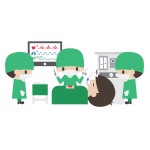Pulseless Electrical Activity (PEA) is a dangerous and life-threatening cardiac arrest situation characterized by unresponsiveness and undetectable pulse in the presence of sufficient electrical activity of the heart. It indicates a severe impairment in the heart’s ability to meet the adequate blood flow demands of the body despite the presence of electrical activity, requiring immediate medical intervention to address the underlying pathology and restore normal circulation.
The medical mnemonic “PATCH MED” concisely encompasses a range of potential underlying causes of pulseless electrical activity (PEA). Each letter signifies a distinct factor—Pulmonary embolism, Acidosis, Tension pneumothorax, Cardiac tamponade, Hypovolemia, Medications, Electrolyte disturbances, and Drug overdose—that highlights the multifaceted pathologies and risk factors contributing to this life-threatening condition. By employing this mnemonic, medical professionals can efficiently recall and address the diverse underlying causes of PEA, guiding urgent interventions and resuscitative efforts made by the medical staff to improve patient outcomes.
Pulseless Electrical Activity Causes Mnemonic
| Letter | Cause | Pathophysiology |
|---|---|---|
| P | Pulmonary embolus | Massive clot obstructs pulmonary circulation, leading to acute right heart failure. |
| A | Acidosis | Severe metabolic acidosis can depress cardiac contractility and disrupt conduction. |
| T | Tension pneumothorax | Accumulating air in the pleural space compresses the heart and decreases venous return. |
| C | Cardiac tamponade | Accumulated fluid in the pericardium compresses the heart, impairing its pumping. |
| H | Hypokalemia/ Hyperkalemia/ Hypoxia/ Hypothermia/ Hypovolemia | Various metabolic imbalances compromise cardiac function. |
| M | Myocardial infarction | Infarcted heart muscle leads to pump failure and arrhythmias, causing PEA. |
| E | Electrolyte derangements | Disturbed electrolyte levels can disrupt normal cardiac conduction and function. |
| D | Drugs | Certain medications or toxins can depress cardiac activity or induce arrhythmias. |
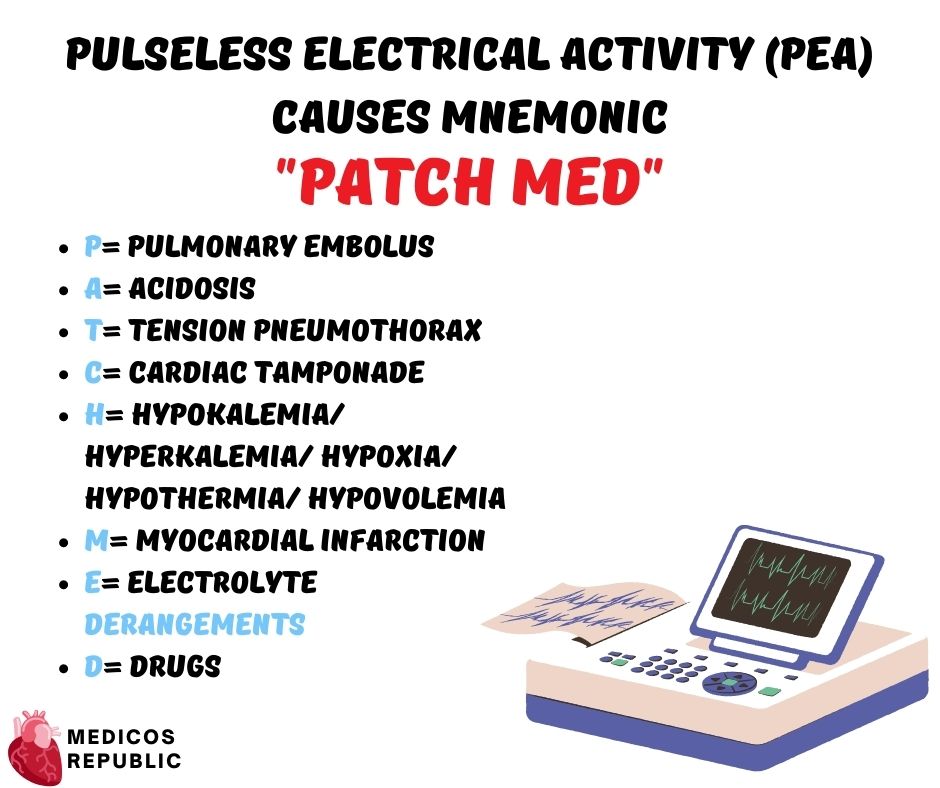
Happy learning, folks! 🙂

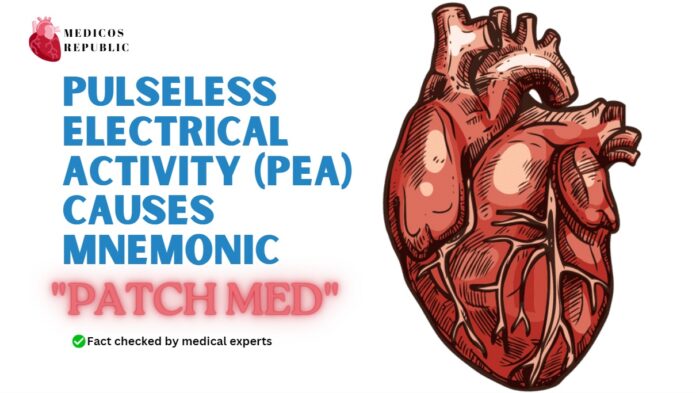

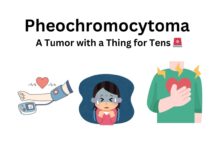
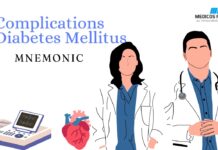
![Carcinoid Syndrome Mnemonic [Easy-to-memorize] Carcinoid Syndrome Mnemonic](https://www.medicosrepublic.com/wp-content/uploads/2024/08/Carcinoid-Syndrome-Mnemonic-Easy-to-memorize-218x150.jpg)

![Stages of Neurocysticercosis Mnemonic [Vegans Can’t Get Neurocysticercosis] Stages of Neurocysticercosis Mnemonic](https://www.medicosrepublic.com/wp-content/uploads/2023/08/Stages-of-Neurocysticercosis-Mnemonic-Vegans-Cant-Get-Neurocysticercosis-1-218x150.jpg)

![Vitamins For Dummies PDF Free Download [Direct Link] Vitamins For Dummies PDF](https://www.medicosrepublic.com/wp-content/uploads/2022/09/Vitamins-For-Dummies-PDF-Free-Download-150x150.jpg)
![Best Books for FCPS Part 1 [Experience Based]](https://www.medicosrepublic.com/wp-content/uploads/2017/08/Best-Books-for-FCPS-Part-1-Experience-Based-150x150.jpg)
![Clinical Handbook of Cardiac Electrophysiology 2nd Edition PDF Free Download [Direct Link] Clinical Handbook of Cardiac Electrophysiology 2nd Edition PDF](https://www.medicosrepublic.com/wp-content/uploads/2023/07/Clinical-Handbook-of-Cardiac-Electrophysiology-2nd-Edition-150x150.jpg)
![Clinical Anatomy: Applied Anatomy for Students and Junior Doctors PDF Free Download [Direct Link] Clinical Anatomy Applied Anatomy for Students and Junior Doctors PDF](https://www.medicosrepublic.com/wp-content/uploads/2022/05/Clinical-Anatomy-Applied-Anatomy-for-Students-and-Junior-Doctors-PDF-Free-Download-150x150.png)
![Vishram Singh General Anatomy PDF Free Download [Direct Link] Vishram Singh General Anatomy PDF](https://www.medicosrepublic.com/wp-content/uploads/2022/05/Vishram-Singh-General-Anatomy-PDF-Free-Download-1-150x150.jpg)
![Top Drugs: Their History, Pharmacology, and Syntheses 1st Edition PDF Free Download [Direct Link] Top Drugs Their History, Pharmacology, and Syntheses 1st Edition PDF](https://www.medicosrepublic.com/wp-content/uploads/2022/08/Top-Drugs-Their-History-Pharmacology-and-Syntheses-1st-Edition-PDF-Free-Download-150x150.jpg)
![BRS Gross Anatomy (Board Review Series) 10th Edition PDF Free Download [Direct Link] BRS Gross Anatomy (Board Review Series) 10th Edition PDF](https://www.medicosrepublic.com/wp-content/uploads/2023/04/BRS-Gross-Anatomy-Board-Review-Series-10th-Edition-PDF-Free-150x150.jpg)
![Fine Needle Aspiration Cytology: Interpretation and Diagnostic Difficulties 2nd Edition PDF Free Download [Direct Link] Fine Needle Aspiration Cytology Interpretation and Diagnostic Difficulties 2nd Edition PDF](https://www.medicosrepublic.com/wp-content/uploads/2022/09/Fine-Needle-Aspiration-Cytology-Interpretation-and-Diagnostic-Difficulties-2nd-Edition-PDF-Free-Download-150x150.jpg)
![AMBOSS Medical Qbanks USMLE Step 2 CK 2023 PDF Free Download [Direct Link] AMBOSS Medical Qbanks USMLE Step 2 CK 2023 PDF](https://www.medicosrepublic.com/wp-content/uploads/2023/02/AMBOSS-Medical-Qbanks-USMLE-Step-2-CK-2023-PDF-Free-Download-150x150.jpg)
